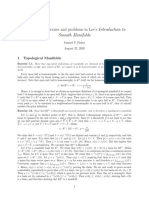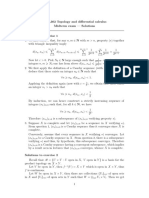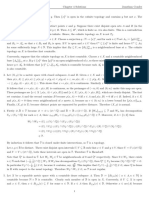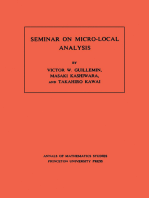0 ratings0% found this document useful (0 votes)
21 viewsNormality of Metric Spaces and The Shrinking Lemma: S S S S S 1 S A A B 1 1
Normality of Metric Spaces and The Shrinking Lemma: S S S S S 1 S A A B 1 1
Uploaded by
Avijit SamantaThe document defines normality of metric spaces and proves the shrinking lemma. It defines a normal topological space as one where disjoint closed subsets have disjoint open neighborhoods. It then proves that all metric spaces are normal by constructing a Urysohn function that separates closed sets. Finally, it proves the shrinking lemma, which allows shrinking open covers in normal spaces.
Copyright:
© All Rights Reserved
Available Formats
Download as PDF, TXT or read online from Scribd
Normality of Metric Spaces and The Shrinking Lemma: S S S S S 1 S A A B 1 1
Normality of Metric Spaces and The Shrinking Lemma: S S S S S 1 S A A B 1 1
Uploaded by
Avijit Samanta0 ratings0% found this document useful (0 votes)
21 views1 pageThe document defines normality of metric spaces and proves the shrinking lemma. It defines a normal topological space as one where disjoint closed subsets have disjoint open neighborhoods. It then proves that all metric spaces are normal by constructing a Urysohn function that separates closed sets. Finally, it proves the shrinking lemma, which allows shrinking open covers in normal spaces.
Original Title
t4shrnk
Copyright
© © All Rights Reserved
Available Formats
PDF, TXT or read online from Scribd
Share this document
Did you find this document useful?
Is this content inappropriate?
The document defines normality of metric spaces and proves the shrinking lemma. It defines a normal topological space as one where disjoint closed subsets have disjoint open neighborhoods. It then proves that all metric spaces are normal by constructing a Urysohn function that separates closed sets. Finally, it proves the shrinking lemma, which allows shrinking open covers in normal spaces.
Copyright:
© All Rights Reserved
Available Formats
Download as PDF, TXT or read online from Scribd
Download as pdf or txt
0 ratings0% found this document useful (0 votes)
21 views1 pageNormality of Metric Spaces and The Shrinking Lemma: S S S S S 1 S A A B 1 1
Normality of Metric Spaces and The Shrinking Lemma: S S S S S 1 S A A B 1 1
Uploaded by
Avijit SamantaThe document defines normality of metric spaces and proves the shrinking lemma. It defines a normal topological space as one where disjoint closed subsets have disjoint open neighborhoods. It then proves that all metric spaces are normal by constructing a Urysohn function that separates closed sets. Finally, it proves the shrinking lemma, which allows shrinking open covers in normal spaces.
Copyright:
© All Rights Reserved
Available Formats
Download as PDF, TXT or read online from Scribd
Download as pdf or txt
You are on page 1of 1
Normality of metric spaces and the shrinking lemma
Definition: A topological space is normal (a.k.a. T4 ) whenever given two disjoint closed subsets A, B, there exist
disjoint open subsets U, V such that A ⊆ U, B ⊆ V .
Theorem: If (X, d) is a metric space, then it is normal.
Proof: Given S ⊆ X, define fS : X → R by fS (x) = d(x, S) = inf {d(x, a): a ∈ S}. Then fS ≥ 0, fS is continuous
def
and fS (x) = 0 ⇔ x ∈ S. In particular, if S is closed, then S = fS−1 ({0}).
Let f = fA /(fA + fB ). Then 0 ≤ f ≤ 1. Since A and B are disjoint the denominator is never zero, so f is
continuous. Furthermore f ≡ 0 on A and f ≡ 1 on B. Let U = f −1 ((−∞, 1/2)) and V = f −1 ((1/2, ∞)).
Note: A function with the properties of f is called a Urysohn function after Pavel Urysohn (b. Odessa 1898,
drowned off the coast of Bretagne 1924). The existence of a Urysohn function clearly implies normality. Urysohn’s
lemma (4.3.1 [2], VII.4.1 [1]) proves the existence of such a function for any two disjoint closed subsets of an
arbitrary normal space. Munkres calls it the first deep theorem of his book.
Lemma: Suppose X is normal, and {U, V } is an open cover of X. Then there exists an open set W such that
W ⊆ U and {W, V } is still an open cover of X.
Proof: Since X = U ∪V , U c ∩V c = Ø. By normality there exist disjoint open sets S, W such that U c ⊆ S, V c ⊆ W .
Then S c ⊆ U and W c ⊆ V , so in particular X = W ∪ V . Since W ∩ S = Ø, W ⊆ S c . Thus, W ⊆ S c ⊆ U .
Shrinking Lemma: Suppose X is normal, and {Ui : i = 1, ...n} is a finite open cover of X. Then there exist open
sets Wi such that Wi ⊆ Ui and {Wi : i = 1, ...n} is still an open cover of X.
Proof: Induction on the preceding lemma.
Note: The shrinking lemma can be generalized to an infinite cover as long as it is point-finite, i.e. each point
of X is in at most finitely many covering sets. The proof is by transfinite induction. This shrinking property is
equivalent to normality (VII.6.1 [1]).
References:
[1] J. Dugundji, Topology, Allyn and Bacon, 1966
[2] J. Munkres, Topology: a first course, Prentice-Hall, 1975
Copyright 1999 Dr. Dmitry Gokhman
You might also like
- Solutions To Exercises and Problems in Lee's Introduction To Smooth ManifoldsDocument32 pagesSolutions To Exercises and Problems in Lee's Introduction To Smooth ManifoldsGabriel medinaNo ratings yet
- Topology Notes 00Document11 pagesTopology Notes 00James MlotshwaNo ratings yet
- 325 HW 06Document2 pages325 HW 06Hyunjoo Noh100% (1)
- Set Theory by SM SrivastavaDocument37 pagesSet Theory by SM SrivastavaRAMJANNo ratings yet
- Chapter 11 SolutionsDocument3 pagesChapter 11 SolutionsAli INo ratings yet
- Existence of Continuous FunctionDocument5 pagesExistence of Continuous FunctionPrabal AcharyaNo ratings yet
- Measurable SelectionDocument17 pagesMeasurable SelectionpochiasdfNo ratings yet
- Lecture 2Document7 pagesLecture 2vinay PALNo ratings yet
- FA09Document6 pagesFA09cbseadvisor1No ratings yet
- 190 W 16 HW8 SolnDocument3 pages190 W 16 HW8 Solnalfonso_bajarNo ratings yet
- 5 Espacios CompactosDocument16 pages5 Espacios CompactosPercomp CpNo ratings yet
- Baire Category TheoremDocument2 pagesBaire Category TheoremRin VanNo ratings yet
- Solutions To Problem Set 3: Limits and ClosuresDocument4 pagesSolutions To Problem Set 3: Limits and ClosuresanthalyaNo ratings yet
- Urysohn's Lemma: 22M:132 Fall 07 J. SimonDocument4 pagesUrysohn's Lemma: 22M:132 Fall 07 J. SimonMohammad SaubanNo ratings yet
- Ideal Hausdorff SpaceDocument2 pagesIdeal Hausdorff SpaceInternational Organization of Scientific Research (IOSR)No ratings yet
- ManifoldDocument7 pagesManifoldeuclidousNo ratings yet
- Closed sets and the Zariski topology: q 1 n 1 n n + α α α 1 α 2 α n α α iDocument68 pagesClosed sets and the Zariski topology: q 1 n 1 n n + α α α 1 α 2 α n α α iNacho IbarraNo ratings yet
- Differential Geometr1Document17 pagesDifferential Geometr1hayatianjourneyNo ratings yet
- Compact 1Document9 pagesCompact 1AHALYA ANINo ratings yet
- Math 142, Spring 2012. HW1 Solutions: X Y 1 1 1 R 0 R R 0 R 1 1 1 1 1 1Document1 pageMath 142, Spring 2012. HW1 Solutions: X Y 1 1 1 R 0 R R 0 R 1 1 1 1 1 1Patricia Calvo PérezNo ratings yet
- Printed by Mathematica For StudentsDocument11 pagesPrinted by Mathematica For StudentsEpic WinNo ratings yet
- U565sp06 MidsolDocument2 pagesU565sp06 MidsolSaraNo ratings yet
- mth427 Notes 14Document6 pagesmth427 Notes 14s06288346No ratings yet
- Solutions To Chapter 8 ExercisesDocument2 pagesSolutions To Chapter 8 ExercisesM Burhan JafeerNo ratings yet
- Topology Note March 8Document3 pagesTopology Note March 8Lazarus PittNo ratings yet
- Almost Continuous Function in TopologyDocument39 pagesAlmost Continuous Function in TopologyS.Ramesh Senthil kumarNo ratings yet
- Midterm 2021 Topology SolutionsDocument3 pagesMidterm 2021 Topology SolutionsninimanagadzeNo ratings yet
- Mid-Term Exam: Geometry/Topology IDocument3 pagesMid-Term Exam: Geometry/Topology IJuwandaNo ratings yet
- Chapter 2. Topological Spaces: Proofs Covered in ClassDocument45 pagesChapter 2. Topological Spaces: Proofs Covered in ClassJeoff Libo-onNo ratings yet
- Section3 PDFDocument10 pagesSection3 PDFMnjNo ratings yet
- 1 Baire's Theorem and Its ApplicationsDocument5 pages1 Baire's Theorem and Its ApplicationsJosephPmNo ratings yet
- 04 - Congergent SequencesDocument3 pages04 - Congergent SequencesANDRES DAVID GUEVARA MENDOZANo ratings yet
- 01 Top PDFDocument8 pages01 Top PDFAsifNo ratings yet
- 7500 CDocument17 pages7500 Csalmanjokar8877No ratings yet
- 4 Sums, Intersections and Direct Sums of Subspaces: 4.1 A Dimension FormulaDocument3 pages4 Sums, Intersections and Direct Sums of Subspaces: 4.1 A Dimension Formulaaba3abaNo ratings yet
- 1 Complete Metric SpacesDocument5 pages1 Complete Metric SpacesKuldeepNo ratings yet
- Ma651 Topology Lecture 6 Separation AxiomsDocument16 pagesMa651 Topology Lecture 6 Separation Axiomsfarsamuels183No ratings yet
- MS-E2148 Dynamic OptimizationDocument85 pagesMS-E2148 Dynamic Optimizationpancho_davNo ratings yet
- Topology AssignmentDocument6 pagesTopology AssignmentShadowMasterNo ratings yet
- Chapter9 TOPOLOGYDocument25 pagesChapter9 TOPOLOGYKartik KumarNo ratings yet
- 1 02 ConvergenceDocument13 pages1 02 ConvergenceAyhan ErciyesNo ratings yet
- Hartshorne Algebraic Geometry SolutionsDocument130 pagesHartshorne Algebraic Geometry SolutionsΠΤΟΛΕΜΑΙΟΣ ΗΡΑΚΛΕΙΔΗΣ50% (2)
- 1 Review of Topology: 1.1 Metric SpacesDocument4 pages1 Review of Topology: 1.1 Metric SpacesPrivate27No ratings yet
- Teste1 ResolDocument3 pagesTeste1 ResolEdmilson BarrosNo ratings yet
- Strongly Teta Semi ContinuidadDocument13 pagesStrongly Teta Semi ContinuidadCarlos GranadosNo ratings yet
- Urysohn's LemmaDocument3 pagesUrysohn's LemmaArup AbinashNo ratings yet
- Applications of Baire Category TheoremDocument11 pagesApplications of Baire Category TheoremUrvashiNo ratings yet
- ch4 FollandDocument11 pagesch4 FollandDreamerNo ratings yet
- Compactness, IDocument10 pagesCompactness, IGolu MoluNo ratings yet
- Math 205 Asolutions 3Document19 pagesMath 205 Asolutions 3HANCEL MIRANDA GARCIANo ratings yet
- Sample Exam, F10PC Solutions, Topology, Autumn 2011Document5 pagesSample Exam, F10PC Solutions, Topology, Autumn 2011JenifaNo ratings yet
- Topological Mathematical PapersDocument3 pagesTopological Mathematical PapersDefinitely JunkieNo ratings yet
- Sample Exam, F11PE Solutions, Topology, Autumn 2011Document5 pagesSample Exam, F11PE Solutions, Topology, Autumn 2011Jeoff Libo-onNo ratings yet
- Expository ProjectDocument2 pagesExpository ProjectdanNo ratings yet
- Elgenfunction Expansions Associated with Second Order Differential EquationsFrom EverandElgenfunction Expansions Associated with Second Order Differential EquationsNo ratings yet
- M.Sc. Course in Applied Mathematics With Oceanology and Computer Programming Semester-IV Paper-MTM402 Unit-1Document26 pagesM.Sc. Course in Applied Mathematics With Oceanology and Computer Programming Semester-IV Paper-MTM402 Unit-1Avijit SamantaNo ratings yet
- M.Sc. Course in Applied Mathematics With Oceanology and Computer Programming Semester-IV Paper-MTM402 Unit-1Document15 pagesM.Sc. Course in Applied Mathematics With Oceanology and Computer Programming Semester-IV Paper-MTM402 Unit-1Avijit SamantaNo ratings yet
- Pgadm2020 FCS MeritlistDocument28 pagesPgadm2020 FCS MeritlistAvijit SamantaNo ratings yet
- Complete Metric Space: 1 SequenceDocument44 pagesComplete Metric Space: 1 SequenceAvijit SamantaNo ratings yet
- Public Service Commission, West Bengal Advertisement No.10/2021Document3 pagesPublic Service Commission, West Bengal Advertisement No.10/2021Avijit SamantaNo ratings yet
- 9ABS302-Mathematics-III SET1Document1 page9ABS302-Mathematics-III SET1Avijit SamantaNo ratings yet
- Personal Details: Admission Application View Form For Academic Year 2020 - 2021Document3 pagesPersonal Details: Admission Application View Form For Academic Year 2020 - 2021Avijit SamantaNo ratings yet


































































